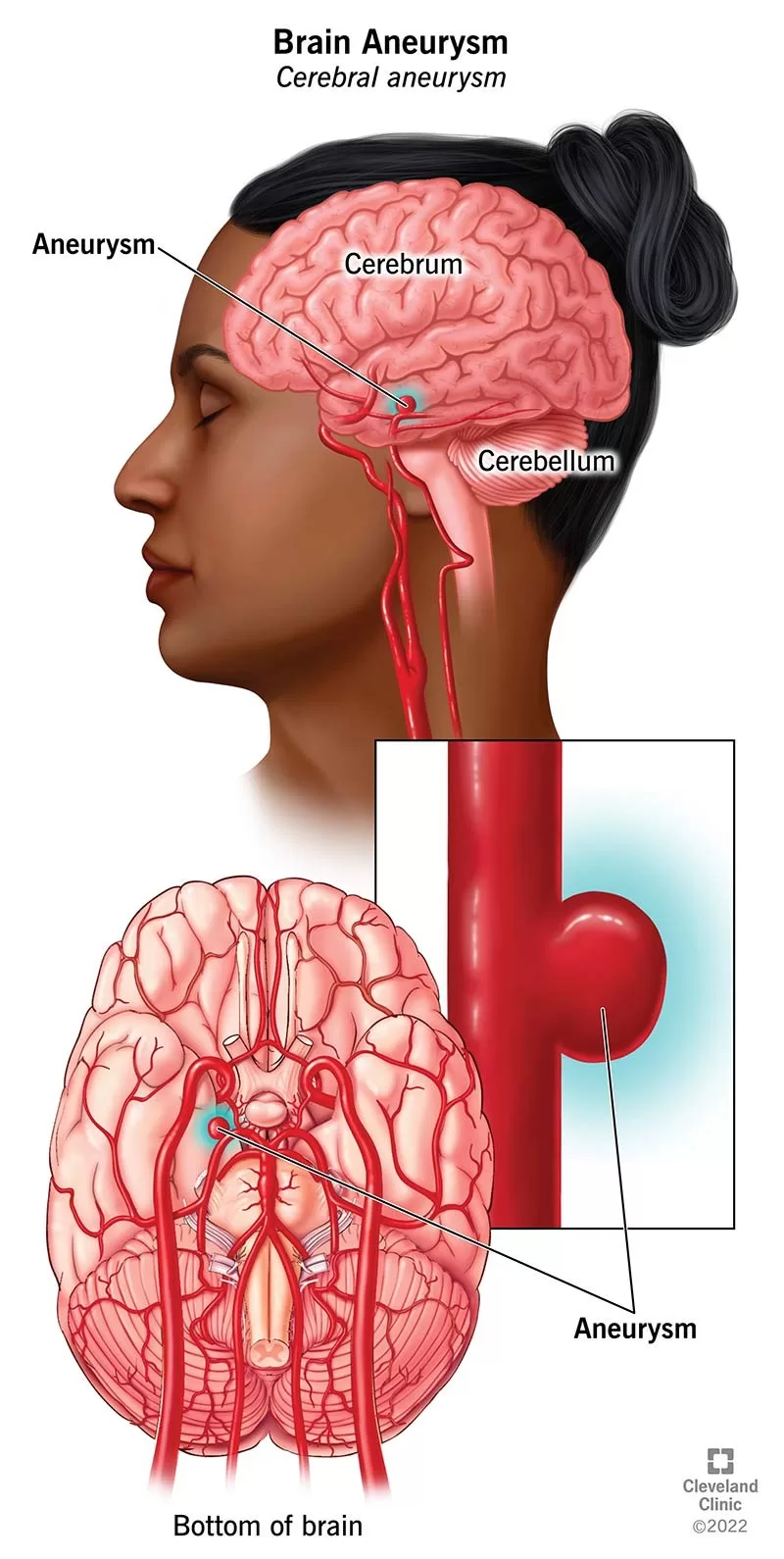Brain aneurysms, also known as cerebral aneurysms, are alarming medical conditions that can pose severe risks if not recognized and treated early. These abnormal bulges in the blood vessel walls of the brain may develop silently over time, often without any noticeable symptoms, making awareness crucial for maintaining brain health. The causes of brain aneurysms can range from genetic predispositions to lifestyle factors such as smoking and hypertension. When a brain aneurysm ruptures, it can lead to catastrophic outcomes, including intense headaches and even stroke. Understanding brain aneurysm symptoms and seeking immediate medical intervention can significantly improve survival rates and health outcomes, emphasizing the importance of education and vigilance regarding this serious health issue.
When discussing aneurysms within the cranial cavity, the terms “cerebral bulge” and “intracranial artery abnormality” are commonly used alternative phrases. These highlighted conditions can manifest mysteriously with minimal warning signs, often necessitating thorough medical evaluation to identify underlying causes. The rupture of such cerebral anomalies can trigger life-threatening situations, underscoring the necessity for individuals to comprehend both the symptoms and risks associated with these brain-related issues. Like other vascular health concerns, understanding and mitigating the factors leading to these cerebral irregularities can further promote optimal brain health and personalized patient care.
Recognizing Brain Aneurysm Symptoms: The Importance of Early Detection
Identifying the symptoms of a brain aneurysm is crucial for effective medical intervention, especially since many aneurysms are asymptomatic until they grow or rupture. Common signs of an unruptured brain aneurysm can include persistent headaches, visual disturbances, and localized numbness. Individuals may mistakenly attribute these symptoms to stress or simple headaches, thus delaying necessary medical evaluations. It is vital for anyone experiencing unusual headaches or changes in vision to consult healthcare providers. The distinction between unruptured and ruptured brain aneurysm symptoms cannot be overstated; recognizing these signs can lead to lifesaving actions.
In contrast, when a brain aneurysm ruptures, symptoms rapidly intensify and emergency care becomes imperative. The onset of a thunderclap headache is often a dramatic indicator, characterized by an intense, sudden pain that can signal a life-threatening situation. Additional symptoms like nausea, stiff neck, and sensitivity to light further highlight the severity of a ruptured aneurysm. Understanding these urgent signs not only facilitates quick medical responses but also raises public awareness about the risks associated with brain aneurysms.
Causes of Brain Aneurysms: Unraveling the Risk Factors
The causes of brain aneurysms are multifaceted, touching upon genetics, lifestyle choices, and existing medical conditions. Research suggests that individuals with a family history of brain aneurysms carry a heightened risk, indicating a potential genetic component to the condition. Chronic health issues such as high blood pressure and atherosclerosis significantly contribute to the weakening of blood vessel walls, creating a more conducive environment for aneurysms to form. Additionally, certain connective tissue disorders, like Ehlers-Danlos syndrome, can play a critical role in the pathology of cerebral aneurysms.
Lifestyle choices, particularly smoking and excessive alcohol intake, have been established as significant risk factors for developing brain aneurysms. These habits not only impair overall brain health but also escalate the likelihood of vascular weaknesses. Furthermore, age and gender also influence susceptibility, with women being disproportionately affected in certain demographics. Understanding these causes is essential for at-risk individuals looking to make informed lifestyle changes aimed at reducing risk.
Understanding the Impact of Ruptured Aneurysms on Health
Ruptured brain aneurysms can lead to catastrophic health events, most notably hemorrhagic strokes, which often result in significant morbidity or mortality. The sudden release of blood into the cranial cavity can cause immediate neurological damage, overwhelming the body’s capacity to deliver oxygen and nutrients to the brain. This acute condition underscores the importance of quick medical intervention, as timely treatment can mean the difference between recovery and severe long-term complications.
In the aftermath of a rupture, survivors may face a long and challenging recovery process, including rehabilitation for motor skills and cognitive function impacted by hemorrhagic strokes. The emotional toll on patients and their families can be profound, requiring support for both physical and psychological healing. Recognizing the potential consequences of ruptured aneurysms is crucial—not only for immediate medical responses but also for long-term care planning and rehabilitation efforts.
Preventative Measures for Brain Aneurysms: Taking Action
Taking proactive steps towards brain health can mitigate the risk of developing brain aneurysms. Key preventative measures include managing chronic health conditions such as hypertension through lifestyle changes and medication adherence. Maintaining a balanced diet, engaging in regular physical activity, and avoiding tobacco and excessive alcohol consumption play critical roles in enhancing vascular health. Individuals should also get regular check-ups to monitor their overall health and stay informed about their risks, particularly if they have a family history of brain aneurysms.
Moreover, awareness campaigns emphasizing the signs and symptoms of brain aneurysms can empower individuals to seek timely medical advice. Educational resources and community discussions can further improve understanding, enabling prompt intervention before an aneurysm becomes a critical health issue. By prioritizing brain health and recognizing risk factors, individuals can take charge of their well-being and significantly reduce their chances of experiencing this serious condition.
Ongoing Research and Future Directions in Aneurysm Treatment
The medical community continually seeks to improve understanding and treatment methodologies for brain aneurysms through ongoing research. Current studies focus on identifying genetic markers that may indicate susceptibility, enabling early detection strategies tailored to high-risk individuals. Advances in imaging technologies are also playing a pivotal role, allowing for more precise diagnostics and monitoring of aneurysms, thereby enhancing the ability to predict rupture risks.
Additionally, novel treatment protocols, such as minimally invasive surgical techniques and innovative endovascular therapies, are being evaluated for efficacy in managing aneurysms. These advancements offer promising alternatives to traditional methods, aiming to improve patient outcomes while minimizing recovery times. The continuous exploration of these avenues underscores the importance of research in shaping the future of brain aneurysm management and ensuring that patients receive the best possible care.
Frequently Asked Questions
What are the primary symptoms of brain aneurysms?
Brain aneurysm symptoms can vary significantly, with many unruptured aneurysms being asymptomatic. However, if an aneurysm grows larger, symptoms may include persistent headaches, vision problems like double vision or blurriness, numbness or weakness on one side of the body, and dilated pupils. In cases of a ruptured aneurysm, symptoms become severe and include a sudden, intense headache often described as a ‘thunderclap headache’, nausea, vomiting, neck stiffness, sensitivity to light, and seizures.
What causes brain aneurysms to develop?
The causes of brain aneurysms are not entirely clear, but several risk factors contribute to their development. These include genetic predispositions such as a family history of aneurysms, medical conditions like high blood pressure and atherosclerosis, and lifestyle choices including smoking and excessive alcohol consumption. Age and gender also play a role, as brain aneurysms are more common in women aged 30 to 60.
How can I tell if I have a ruptured aneurysm?
A ruptured aneurysm can present with alarming and sudden symptoms. Key indicators include a severe ‘thunderclap headache’, which is often the worst headache a person has ever experienced. Other symptoms may include nausea, vomiting, a stiff neck, sensitivity to light, and the occurrence of seizures. Immediate medical attention is critical if any of these symptoms appear.
Are there preventive measures for brain aneurysms?
While not all brain aneurysms can be prevented, there are several strategies to reduce the risk. Maintaining good brain health through regular medical check-ups, managing chronic conditions like hypertension, avoiding smoking, limiting alcohol intake, and managing stress can help. Awareness of family health history related to cerebral aneurysms is also important, as genetic factors may play a significant role.
What should I do if I suspect a brain aneurysm?
If you suspect you may have a brain aneurysm, especially if experiencing severe headaches or neurological changes, it is crucial to seek immediate medical evaluation. Healthcare providers may use imaging studies such as CT scans or MRIs to diagnose the condition. Early detection can significantly improve treatment outcomes and reduce risks associated with brain aneurysms.
| Key Point | Details |
|---|---|
| Definition of Brain Aneurysms | An abnormal bulge in a weakened area of a brain blood vessel, potentially life-threatening if it ruptures. |
| Causes | 1. Genetics: family history increases risk. 2. Medical Conditions: high blood pressure, atherosclerosis. 3. Lifestyle Factors: smoking, alcohol consumption. 4. Age and Gender: more common in women aged 30-60. |
| Symptoms of Unruptured Aneurysms | Often asymptomatic. Larger aneurysms may cause persistent headaches, visual impairments, localized numbness, and pupil dilation. |
| Symptoms of Ruptured Aneurysms | Sudden severe headaches (thunderclap headache), nausea, stiff neck, photophobia, and seizures. |
| Importance of Awareness | Recognizing the symptoms is crucial for timely intervention, which can save lives. |
Summary
Brain aneurysms are critical medical conditions that require immediate attention and understanding. A brain aneurysm, characterized as a bulge in a blood vessel in the brain, can be asymptomatic for long periods but poses severe risks if ruptured. Factors contributing to brain aneurysms include genetics, chronic medical conditions, lifestyle choices, and age, particularly affecting women between 30 and 60 years. Symptoms such as severe headaches, nausea, and changes in vision should not be ignored, as timely medical intervention is vital for a positive outcome. Increasing awareness about brain aneurysms can lead to early detection and better management of this potentially deadly condition.
The content provided on this blog (e.g., symptom descriptions, health tips, or general advice) is for informational purposes only and is not a substitute for professional medical advice, diagnosis, or treatment. Always seek the guidance of your physician or other qualified healthcare provider with any questions you may have regarding a medical condition. Never disregard professional medical advice or delay seeking it because of something you have read on this website. If you believe you may have a medical emergency, call your doctor or emergency services immediately. Reliance on any information provided by this blog is solely at your own risk.







